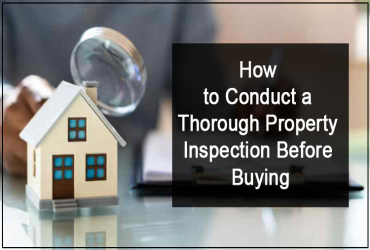
Purchasing property is one of the most significant investments a person can make, and ensuring that this investment requires a detailed and thorough property inspection. A property inspection helps identify potential issues, assess the condition of the property, and ensure that it aligns with your expectations. Here’s a comprehensive guide on how to conduct a thorough property inspection before buying.
Why Property Inspections Are Crucial
A property inspection is not just about checking cosmetic flaws, it is about uncovering hidden issues that could lead to costly repairs down the line. It provides insight into structural integrity, safety hazards, and the lifespam of major systems like electrical, plumbing, and HVAC.
Steps to Conducting a Thorough Property Inspection
1. Prepare for the Inspection
Before diving into the inspection process, preparation is key:
|
Hire a Professional Inspector: While you can conduct a visual inspection yourself, hiring a certified home inspector ensures that all critical aspects are evaluated professionally. |
|
Review Previous Inspector: If available, review any prior inspection reports or records of repairs to understand the property’s history. |
|
Create an Inspection Checklist: This helps ensure no area is overlooked during the process. Include items such as structural components, electrical wiring, HVAC units, and exterior features. |
2. Inspect Exterior Features
A property's exterior frequently provides information about its general state.
|
Foundation and Structure: Look for cracks in walls or foundations, as these may indicate structural issues. |
|
Roof: Check for leaks, missing shingles, or damage to gutters and chimneys. |
|
Doors and Windows: Verify that all exterior doors and windows open, close, and lock properly. Look for any holes or drafts that can compromise energy efficiency. |
|
Drainage and Grading: Ensure proper drainage around the house to prevent water pooling near the foundation. |
3. Examine Interior Components
The interior inspection focuses on systems and features that impact daily living.
Rooms
|
Examine the floors, walls, ceilings for cracks, and any indications of water damage. |
|
Check doors and windows for functionality. |
|
Examine built-in fixtures like countertops and cabinets for tear and wear. |
Plumbing
|
Look under sinks for leaks or corrosion. |
|
Test faucets, toilets for proper water pressure. |
|
Inspect water heaters and sump pumps for functionality. |
Electrical Systems
|
Ensure outlets work correctly. |
|
Check circuit breakers for signs of overloading. |
|
Verify grounding and wiring conditions. |
HVAC Systems
|
Tested heating and cooling units. |
|
Inspecting ductwork for leaks or poor insulation. |
|
Check thermostats for accuracy. |
4. Investigate Hidden Areas
Some areas are less visible but equally important.
Attic
|
Inspect insulation levels, roof conditions from inside, ventilation, and signs of pest infestations. |
Basement/crawl space
|
Look for moisture issues, damage to subflooring, or evidence of pests. |
Garage
|
Test garage doors and operators. Check walls and floors for cracks or damage. |
Using Inspection Results
After your inspection is over, make strategic use of the results:
1. Negotiation Tool
Inspection results can be used to negotiate repairs with the seller or adjust the purchase price if significant repairs are needed.
2. Walk Away from Problematic Deals
Major cautions like extensive mold issues or structural damage may warrant reconsidering your purchase decision altogether
Conculsion
Conducting a thorough property inspection is essential to making an informed decision when buying a home. By carefully evaluating both visible components and hidden areas of the property while documenting findings systematically, you can avoid costly surprises after purchase.


.png)


3 Comments